While there are many literary giants who drank as well as they wrote, Ernest Hemingway may be the all-time champ. (Sorry Charles Bukowski.)
Papa not only liked a good cocktail (or a few), but also included myriad thirst-inducing passages in his books. Starting with his first real novel, The Sun Also Rises, which is celebrating its 90th anniversary of publication this year, Hemingway’s characters were seldom found without a glass, a bottle, or a wineskin in their hands.
According to legend, he created his own eponymous variation of the classic daiquiri, which still appears on bar menus, and a potent Champagne-and-absinthe concoction called Death in the Afternoon.
His writing seems particularly relevant today considering the recent rebirth of the cocktail—and that his style of drinking is finally back in vogue.
We as a country seem to be following in his footsteps: In 2015, according to the latest figures released by the Distilled Spirits Council of the United States earlier this week, the United States consumed 215 million 9-liter cases of booze, which was up 4.9 million cases from the previous year.
If Hemingway lived today, he’d surely be drinking with the people, holding court in one of New York’s hip downtown cocktail joints.
There are so many drinking scenes in his books that drinks historian Philip Greene wrote a fascinating Hemingway cocktail companion called To Have and Have Another, which came out in 2012. (A second edition of the book was recently released with even more info, plus a section of Hemingway-inspired elixirs from top modern bartenders.)
“He wants the reader to feel what the character was feeling,” explains Greene. “He’s telling you something about the character by what he’s drinking and where he’s drinking.”
While many of us will have to settle for living vicariously through Hemingway’s experiences—bull fighting in Spain, hunting big game in Africa—we can certainly enjoy a drink he featured in one of his stories, whether it be a bracing Americano (The Good Lion) or a gin gimlet (Green Hills of Africa).
But pinning down what Hemingway preferred to imbibe is a bit trickier. The truth is he drank just about everything, from cocktails to bubbly to beer to whiskey. (In fact, he probably drank too much for his own good.)
And, according to Greene, though he took Campari and his beloved Gordon’s Gin and Rose’s Lime Juice (for gimlets, of course) along on an African safari, he wasn’t afraid to try new things. “He’s going to drink what the locals drink,” says Greene. “I think he was an omnivore.”
(Proof? On his honeymoon in China with his third wife, war correspondent Martha Gellhorn, who was in the country on assignment, he drank rice wine. “He didn’t like it, but that was what was available,” says Greene.)
It didn’t hurt either that Hemingway could hold his liquor for the most part. “He had a prodigious tolerance,” says Greene, noting that many of the writer’s contemporaries were lightweights. “Fitzgerald didn’t have much of a tolerance. Ian Fleming didn’t have much of a tolerance.”
Hemingway was prone to fabrication, but one drinking yarn we know is true involves the legend of his downing 17 double daiquiris at famed Floridita in Cuba in a single session. (“There’s no doubt he did that one,” says Greene.)
But when it came to martinis, smaller was better. He didn’t like them too big because they would get warm, so he went as far as to make jumbo ice cubes by filling old metal tennis ball cans with water and freezing them. (Hemingway froze his cocktail onions, too.) He was also very specific when it came to the cocktail’s recipe: 3/4 ounces gin and “just enough vermouth to cover the bottom of the glass,” wrote Hemingway in a 1949 letter.
The drink naturally shows up in a couple of his books, with one of the most memorable passages appearing in A Farewell to Arms: “The sandwiches came and I ate three and drank a couple more martinis. I had never tasted anything so cool and clean. They made me feel civilized.”
Who could argue with that?






